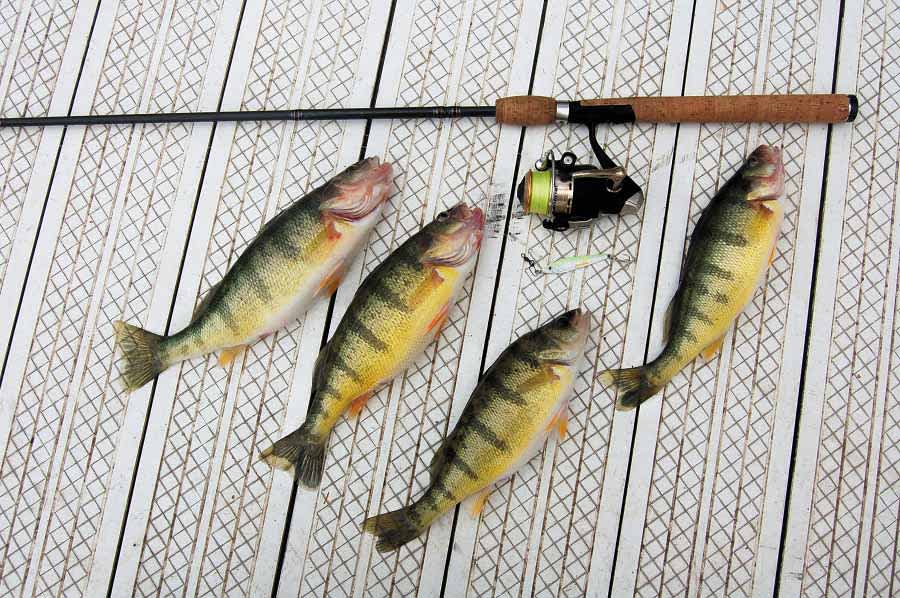Michigan Family Panfish Fun is Just a Lake Away
Bob Gwizdz 06.08.15

Merriam-Webster defines panfish as “a small food fish (as a sunfish) usually taken with hook and line and not available on the market.”
I take exception to the last part of that definition as yellow perch, one of the most toothsome of all pisces, is certainly a panfish and is commercially available across the country. Perhaps a more commonly accepted popular definition is more applicable: fish that rarely grow larger than a frying pan or fish that are suitable for the pan.
But there’s no doubt about the first half of the definition as food fish; panfish are great in the pan. And they’re great for anglers as they are typically numerous, widespread, and not too difficult to catch. They are a great target for beginning anglers. Michigan has numerous species that are classified as panfish and most are available just about everywhere.
The most popular of the Michigan’s panfish species include the various sunfishes (bluegills are the dominant example, but red-eared sunfish and pumpkinseeds qualify as well), crappie, and yellow perch.
There’s no doubt that bluegills—and to a lesser extent the other sunfish—are the top target of most anglers. They are found statewide, most often in shallow, weedy environments, and are easily caught year-round, though they are most easily caught right now. Bluegills are community nesters that move into the shallows (in sometimes as little as a foot of water) in droves. Anglers who can locate the bluegill beds can often catch limits without ever moving.
The easiest way to catch bluegills is with a hook and live bait, such as a worm or cricket. You can fish them under a bobber or on bottom without sophisticated gear; a basic rod with a simple push-button reel is perfect, but plenty of anger still catch them on cane poles. You can make it more involved if you like; lots of anglers get great satisfaction out of fishing for ‘gills with a fly rod and sponger spiders or popping bugs, but it’s not necessary. If taking your youngster out to catch fish is the goal, it’s hard to beat a spincasting outfit.
The other common sunfishes behave similarly to bluegills and, in lakes where multiple species exist, it’s not uncommon to catch them all from the same area. Fact is, they often hybridize. Pumpkinseeds, which are native to Michigan, are less widespread than bluegills and feed on a wider range of small prey, including minnows. Redears are not native to Michigan, though they have been transplanted here and thrive in a number of lakes in the southern two or three tiers of counties in the Lower Peninsula.
After spawning, the sunfishes typically move out to deeper water and are usually pretty easy to locate on bottom at the edges of weed beds.
Crappies, which are similarly widespread across Michigan, tend to grow larger than bluegills and are less easy to target. When they move into spawn—usually a few weeks before the bluegills—they’ll inhabit the shallows in prodigious numbers. Minnows are the preferred bait for crappie fishermen, usually fished under a bobber in less than five feet of water.
Michigan boasts both species of crappies: black crappies, which are found in clear, often weedy lakes, and white crappies, which are found in more turbid water, often in rivers and reservoirs. Their spawning and feeding habits are identical.

Unlike the other sunfishes, crappies get harder to find after spawning. They inhabit more open water and often suspend in the water column, making them more difficult to target than bluegills.
What they have in common is that they are often available from the bank. Plenty of anglers have cut their teeth on bluegills and crappies fishing from boat docks or the flats out in front of a cottage.
Perch, meanwhile, can be found a lot of places, as well, but they tend to do best in large lakes with deep water, often in what the biologists call two-story lakes—those that are cold enough to also support trout. The Great Lakes harbor plenty of yellow perch. However, because of changes to the ecosystem caused by invasive species, they are not as numerous or widespread as they once were. While anglers can sometimes access perch from Great Lakes fishing piers, it’s a hit-or-miss proposition. If you hear the perch are “in,” get there right now. You snooze, you lose.
Most Great Lakes perch fishing is done from boats, often in deep water. But not owning a boat doesn’t necessarily take you out of the game. Numerous charter captains offer perch fishing expeditions and there’s even a party boat—a large vessel that individuals can book space on—operating out of St. Joseph that fishes Lake Michigan.
There are plenty of other panfishing opportunities in Michigan (including bullheads, rock bass, white bass, white perch, and even smelt in some places) but that’s another story.
For more information on Michigan fishing go to michigan.org. Click here to purchase a Michigan fishing license online.
This article was produced in partnership with Pure Michigan.

